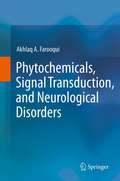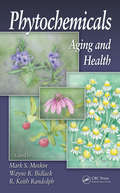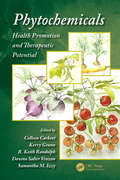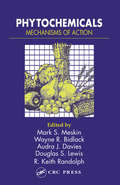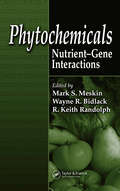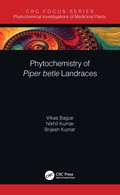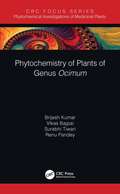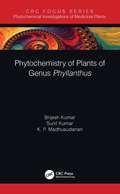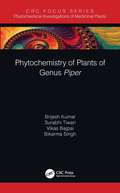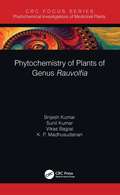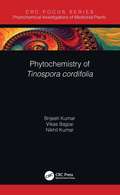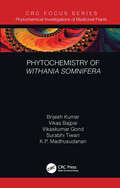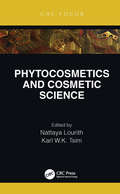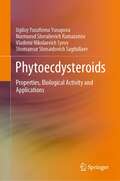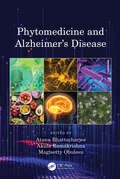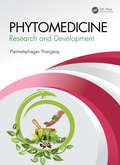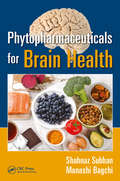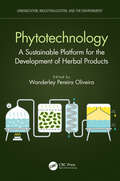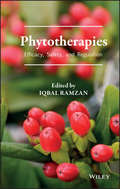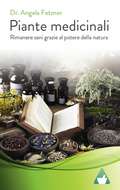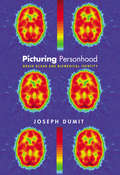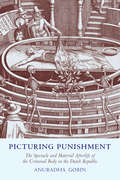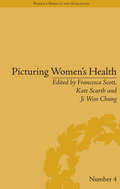- Table View
- List View
Phytochemicals, Signal Transduction, and Neurological Disorders
by Akhlaq A. FarooquiPhytochemicals Signal Transduction and Neurological Disorders Phytochemicals are heterogeneous group of bioactive compounds produced by plants, which are extensively researched by scientists for their health-promoting potentials in human diseases. Unlike vitamins and minerals, phytochemicals are not required for sustaining cell viability, but they play an important role in protecting tissues and cells from the harmful effects of oxidative stress and inflammation. Examples of phytochemicals include catechins, resveratrol, ginkgo biloba, curcumin, and sulfur compounds found in garlic. Although, the precise molecular mechanisms associated with beneficial effects of phytochemicals still remain the subject of intense investigations, but it is becoming increasingly evident that phytochemicals mediate their effects by counteracting, reducing, and repairing the damage caused by oxidative stress and neuroinflammation. In addition, phytochemicals also stimulate the synthesis of adaptive enzymes and proteins through the stimulation of a transcription factor called Nrf2 and induction of phase II detoxifying enzymes. Consumption of phytochemicals induces neurohormetic response that results in the expression of adaptive stress-resistance genes that are responsible for encoding antioxidant enzymes, protein chaperones, and neurotrophic factor (BDNF). Based on the stimulation of signal transduction network and adaptive stress-resistance genes, it is proposed that the use of phytochemicals from childhood to old age along with regular exercise is an important strategy for maintaining normal aging and delaying onset of age-related neurological disorders (stroke, Alzheimer disease, and Parkinson disease). Phytochemicals Signal Transduction and Neurological Disorders presents readers with cutting edge and comprehensive information not only on bioavailability, and mechanism of action of phytochemicals in the brain, but also provides the molecular mechanism associated with beneficial effects of phytochemicals in neurotraumatic (stroke, spinal cord trauma, and traumatic brain injury) and neurodegenerative (Alzheimers disease, Parkinson disease, Huntington disease, and amyotrophic lateral sclerosis) diseases.
Phytochemicals: Aging and Health
by R. Keith Randolph Mark S. Meskin Wayne R. BidlackThe fastest growing demographic in both developed and developing societies around the world, the elderly bring unique medical and financial health-care burdens. In response to this phenomenon, a large and growing body of research is directed toward the science of healthy aging. A substantial amount of observational data points to the consumption o
Phytochemicals: Health Promotion and Therapeutic Potential
by Colleen Carkeet Kerry Grann R. Keith Randolph Dawna Salter Venzon Samantha M. IzzyIncreasing knowledge of the various protective effects of phytochemicals has sparked interest in further understanding their role in human health. Phytochemicals: Health Promotion and Therapeutic Potential is the seventh in a series representing the emerging science with respect to plant-based chemicals. Drawn from the proceedings at the Seventh In
Phytochemicals: Mechanisms of Action
by R. Keith Randolph Mark S. Meskin Wayne R. Bidlack Audra J. Davies Douglas S. LewisPhytochemicals: Mechanisms of Action is the latest volume in a highly regarded series that addresses the roles of phytochemicals in disease prevention and health promotion. The text, an ideal tool for scientists and researchers in the fields of functional foods and nutraceuticals, links diets rich in plant-derived compounds, such as fruit, vegetabl
Phytochemicals: Nutrient-Gene Interactions
by R. Keith Randolph Mark S. Meskin Wayne R. BidlackUnderstanding phytochemical-gene interactions provides the basis for individualized therapies to promote health as well as prevent and treat disease. The authors of Phytochemicals: Nutrient-Gene Interactions examine the interactions between phytochemicals and the human genome and discuss the impact these interactions have on health, aging, a
Phytochemistry of Piper betle Landraces (Phytochemical Investigations of Medicinal Plants)
by Brijesh Kumar Vikas Bajpai Nikhil KumarPiper betle (betel vine) a pan-Asiatic, tropical plant, which can also grow under mild subtropical areas, is essentially grown for leaves which are chewed with array of additives besides slaked lime. The plant is cultivated widely in India and its surrounding areas. Phytochemistry of Piper betel landraces presents a brief on the distribution, historical and cultural aspects, and properties ascribed to this plant in the ancient texts. Phytochemical and pharmacological information has also been included to underscore the importance of this plant in the present time. A detailed account on metabolic profiling employing modern methods is included, such as real-time, direct analysis of the flight mass spectrometric method and chemometric analysis for characterization of the available biodiversity and signatures specific to gender and geographical location. It was also possible to identify the gender of unknown landraces, with the help of principal component analysis. Features: Elaborates on the chemical diversity within Piper betle. Piper betle leaves have mouth freshening antimicrobial compounds. Use of chemical signatures for the identification of different Piper betle landraces, their gender and geographical locations.
Phytochemistry of Plants of Genus Ocimum (Phytochemical Investigations of Medicinal Plants)
by Brijesh Kumar Surabhi Tiwari Vikas Bajpai Renu PandeyOcimum species has been used as a traditional remedy for various ailments such as arthritis, bronchitis, cold, conjunctivitis, diarrhea, dysentery, and flatulence, as well as for healing wounds and lowering blood glucose level. These are characterized by variations in their morphology such as the shape, size and pigmentation of leaves, which cause differences in chemical composition and affect the commercial value of this genus. This book describes phytochemical investigations of Ocimum species using LC-MS/MS instruments to study qualitative and quantitative variations of phytochemicals in different Ocimum species. Features: Collection of Ayurvedic features and scientific analytical and pharmacological evidence of most important medicinal plants of genus Ocimum. Chemical signatures for the identification of Ocimum species. Easy-to-use analytical procedure for quality control of plants of Ocimum species and its herbal products.
Phytochemistry of Plants of Genus Phyllanthus (Phytochemical Investigations of Medicinal Plants)
by Sunil Kumar Brijesh Kumar K. P. MadhusudananSeveral Phyllanthus species are widely used in traditional medicine and herbal formulation for the treatment of a variety of ailments such as flu, dropsy, diabetes, jaundice and bladder calculus. The medicinal properties of these species are due to the presence of lignans, flavonoids, tannins, alkaloids and terpenoids. Phyllanthin and hypophyllanthin are the major lignans from Phyllanthus species having estrogenic properties that reduce toxicity and vascular tension, and protect hepatocytes. This book deals with the importance of separation techniques in screening of major lignans, flavonoids and terpenoids in Phyllanthus species using HPLC/UPLC coupled with mass spectrometric techniques. Features: Collection of Ayurvedic features and scientific evidence of important medicinal plants. Screening of major lignans, flavonoids and terpenoids in plant parts/whole plant extracts and their geographical variations in Phyllanthus amarus. Easy-to-use analytical procedure for the quality control of Phyllanthus and its products.
Phytochemistry of Plants of Genus Piper (Phytochemical Investigations of Medicinal Plants)
by Brijesh Kumar Surabhi Tiwari Vikas Bajpai Bikarma SinghPiper is the representative genus of family Piperaceae. Piper species are pan-tropical in distribution and found in both the hemispheres. As the king of all spices, black pepper, Piper nigrum, led to the global expeditions culminating in the discovery of India and the new world. Piper species have been reported to possess various pharmacological activities such as insecticidal, antibacterial, anti-inflammatory, antiplatelet, anti-hypertensive, antithyroid, antitumor activities and hepatoprotective properties. Botanical authentication of the plants of Piper species is difficult because of the morphological similarity among the species. This book describes ultra-performance liquid chromatography coupled with triple quadrupole electrospray tandem mass spectrometry in multiple reactions monitoring (MRM) mode to study the quantitative variation of thirteen bioactive markers in different plant parts of ten Piper species. Features: Collection of Ayurvedic features and scientific evidence of the most important medicinal plants of Piper species. Describes chemical signatures for identification of Piper species. Provides easy-to-use analytical procedure for quality control of Piper species and its products.
Phytochemistry of Plants of Genus Rauvolfia (Phytochemical Investigations of Medicinal Plants)
by Sunil Kumar Brijesh Kumar Vikas Bajpai K. P. MadhusudananRauvolfia species, commonly known as Sarpagandha, has been traditionally used in Ayurveda for curing high blood pressure, hypertension, snake bites, fever, and mental illnesses. Due to its wide variety and differences in chemical composition, it is necessary to develop an efficient and reliable method for rapid screening and determination of phytochemicals in the extracts of the Rauvolfia species. This book will provide qualitative and quantitative comparative phytochemical investigations of selected medicinal plants from the Rauvolfia genus using liquid chromatography-mass spectrometry (LC-MS) techniques. The results will help in assuring the efficacy and safety of Rauvolfia herbal products. Features: Collection of Ayurvedic features and scientific evidence of important medicinal plants. Discusses chemical signatures for the identification of Rauvolfia (Sarpagandha) and its products. Easy-to-use analytical procedure for quality control of Rauvolfia and its products.
Phytochemistry of Tinospora cordifolia (Phytochemical Investigations of Medicinal Plants)
by Brijesh Kumar Vikas Bajpai Nikhil KumarTinospora cordifolia stem is used as a tonic, vitalizer, and as a remedy for metabolic disorders to treat allergies, diabetes, dysentery, jaundice, heart diseases, leprosy, rheumatoid arthritis, skin diseases, and urinary disorders. It shows anti-inflammatory, analgesic, antipyretic actions and immunosuppressive effects. This book focuses on providing gender and geographical location-based differences in the phytoconstituents of T. cordifolia by the liquid chromatography mass spectrometric method. These methods have potential use in the quality control of T. cordifolia and the screening of herbal preparations. Features: Compilation of ayurvedic features of one of the most important plants of the Indian system of medicines. Useful for all ayurvedic practitioners, researchers, faculty, students, and herbal product manufacturers. Application of advance hyphenated LC-MS techniques for variation study in phytoconstituents.
Phytochemistry of Withania somnifera (Phytochemical Investigations of Medicinal Plants)
by Brijesh Kumar Surabhi Tiwari Vikas Bajpai K. P. Madhusudanan Vikaskumar GondWithania is a genus of the nightshade family of flowering plants distributed in the subtropical regions from the Mediterranean to South East Asia. Only two species, W. somnifera and W. coagulans, are found in India. The most common species is W. somnifera (WS), which occurs naturally in the subtropical regions from the Mediterranean through Africa to the Middle East, the Indian Continent, Sri Lanka, South East Asia, subtropical America and Australia. It is a perennial shrub that grows to 75 cm (.75 m) tall with tomentose branches, oval yellowish green leaves, orange red berries and a papery calyx, and it survives harsher climatic conditions. In Ayurveda it is believed the plants which survive harsh conditions have strong healing and tonification properties. The main bioactive phytoconstituents of WS are withanolides (steroidal lactones), alkaloids, flavonoids, sterols, phenolics and others. Among the various withanolides, withanolide A, withaferin A, withanone and withanolide D are the most abundant, having various activities. WS is a wonder herb with a broad spectrum of pharmacological properties, such as antioxidant, antidepressant, aphrodisiac, antiulcerogenic, antivenom, anti-inflammatory, antiarthritic, anticancer, antiparasitic, antimicrobial, anticancerous, antidiabetic, antitumor, hemopoetic neuroregenerative, immunomodulatory, cardioprotective, radio-sensitizing, rejuvenating, antistress, sedative, hypoglycemic, thyroprotective, adaptogenic, antispasmodic, immunomodulatory, immunostimulant and antiaging properties. The simultaneous quantitative analysis of six major bioactive withanolides in five varieties of WS and in different plant parts (root, stem and leaf) of WS was accomplished. This method is also applicable to control the quality of commercially formulated products which contain WS bioactive compounds. Results indicated the WS variety NMITLI-135 showed the maximum abundance of withanolides at pH 8.5, EC-0.5 dS m−1, ESP-13 in sodic soil. Our results showed this readily available, rapid and reliable method is suitable for the routine analysis and effective quality control of raw materials and finished products. FEATURES Presents a collection of Ayurvedic features and scientific analytical and pharmacological evidence of important medicinal plants of Withania somnifera Useful for natural product researchers, faculty, students and herbal product manufacturers Uses advanced hyphenated techniques for assessing phytoconstituents
Phytocosmetics and Cosmetic Science
by Nattaya Lourith Karl W.K. TsimThis concise guide to cosmetic active ingredients derived from plant sources will bring scientists, researchers in cosmetic science, and dermatology practitioners up to speed with the basic science and its applications in manufacturing and dermatological practice. It acts as a concise and quick reference from key researchers and an up-to-date guide to translation into practice, providing an easy-to-consult resource on a topic of great current interest.
Phytoecdysteroids: Properties, Biological Activity and Applications
by Ugiloy Yusufovna Yusupova Nurmurod Sheralievich Ramazonov Vladimir Nikolaevich Syrov Shomansur Shosaidovich SagdullaevThis book presents the results of comprehensive research of an inadequately studied class of secondary plant metabolites: phytoecdysteroids, which are structural analogs of the hormones of molting and metamorphosis of arthropods. The chemical structures of ecdysteroids isolated from plants of the genera Ajuga, Rhaponticum, and Silene have been established. Data on the physicochemical characteristics, reactivity, metabolism, and biological activity of these compounds are presented in this book. Considerations of the role of ecdysteroids in plants are expressed and data on their pharmacological properties are also given. Issues regarding the use of phytoecdysteroids in practical medicine and, accordingly, the technological aspects of deriving drugs on their basis and biologically active food additives of a fortifying type of action are considered as well.The book is intended for specialists in the fields of bioorganic and organic chemistry, biochemistry, biotechnology, and pharmacology. It is also relevant to scientists of various profiles and teachers and students interested in the problems of the chemistry of natural and physiologically active substances.
Phytomedicine and Alzheimer’s Disease
by Atanu Bhattacharjee, Akula Ramakrishna, and Magisetty ObulesuAlzheimer's disease, one of the most rapidly growing neurodegenerative disorders, is characterized by a progressive loss of memory. Despite several advances in the field of medical therapeutics, a viable treatment for Alzheimer's disease would be of great importance. Medicinal plants represent a largely untapped reservoir of natural medicines and potential sources of anti-Alzheimer’s drugs. The structural diversity of their phytoconstituents makes these plants a valuable source of novel lead compounds in the quest for drugs to treat Alzheimer's disease. Based on traditional literature and up-to-date research, various new therapeutically active compounds have been identified from phytoextracts, which could be useful in the treatment of cognitive disorders. Phytomedicine and Alzheimer’s Disease presents information on Mechanistic aspects of neurodegeneration in Alzheimer’s disease and the role of phytochemicals as restorative agents Understanding the complex biochemical aspects of Alzheimer’s disease Pre-clinical approaches to evaluating drugs to target Alzheimer’s disease Assessing alternative approaches to treating Alzheimer’s disease and the role of alternative medicine to delay the symptomatic progression of this disease Epigenetic changes in Alzheimer’s disease and possible therapeutic or dietary interventions This book serves as an excellent resource for scientific investigators, academics, biochemists, botanists, and alternative medicine practitioners who work to advance the role of phytomedicines in treating Alzheimer’s disease.
Phytomedicine: Research and Development
by Parimelazhagan ThangarajPhytomedicine has become more important and gained constant improvement today for the betterment of health. Herbal medicine plays a significant role in the development of new drugs, contrary to the modern medicinal systems. For more than a decade, there has been a drastic improvement in phytomedicine across the world. This growth has reached a higher level in development by pharmaceutical industries everywhere. People have drifted toward herbal medication and practices for their food and health care. Therefore, in order to create abundant interest in the research of phytosciences, this book is one of the better reference tools. The bioactive compounds in plants need to be explored to know the scientific value and therapeutic properties of the medicinal plants against many diseases. This book contains chapters that are relevant to the advanced research in herbal medicines and will enlighten readers to the importance of medicinal plants as daily sources of nutrition and cures for diseases. This book highlights the unique features of the plants that have not been studied so far for their therapeutic potential. To prove the efficacy of medicinal plants, they have to be studied, examined, and scientifically verified. Hence, this book will better serve the researchers working under different aspects of phytomedicine. Features • The information provided through scientific validation is useful to study the pharmacological activity of herbals and their administration in the modern era. • The readers can find clear understanding in the research and development of phytopharmaceutical drugs. • The ideas incorporated in each chapter reveal the knowledge gained in studying the biological activities of the compounds present in the plant, which are indeed most worthy for the development of drugs. • The harvesting of new ideology toward modern scientific technologies that are employed in the field of pharmacological research.
Phytopharmaceuticals for Brain Health
by Manashi Bagchi Shahnaz SubhanResearch studies demonstrate diet and proper nutrition in conjunction with cognitive, mental, social, and physical activities can significantly help in improving brain health with advancing age, and potentially reduce the risk of cognitive decline. These studies of phytopharmaceuticals and medicinal plants, demonstrate the efficacy of Huperzine A, berry anthocyanins, trans-resveratrol, Ginkgo biloba, Bacopa monniera, Centella asiatica, tocotrienols, and palm oil in boosting brain health and physical well-being. In addition, consumption of marine fishes and general seafood is recommended for long-term nutritional intervention to preserve mental health, hinder neurodegenerative processes, and sustain cognitive capacities in humans. Omega-3 and omega-6 polyunsaturated fatty acids, n-3/n-6 PUFAs, flavonoids, and antioxidants prevent the initiation and progression of many neurological disorders. This book is a comprehensive review of phytopharmaceuticals impacting brain health with emphasis on diverse applications in food and nutrition sciences, biomedicine, neurology and other scientific and medical fields. It details available methods and contains numerous references making this the perfect guide for scientists who want to explore the fascinating world of phytopharmaceuticals with relation to brain health. Phytopharmaceuticals for Brain Health appeals to a diverse range of readers in industry, medical doctors, research and academia, including biologists, biochemists, food scientists, nutritionists and health professionals. Overall, this book brings a classic scenario of neurological problems to possible amelioration using novel nutraceuticals and functional foods.
Phytopharmaceuticals in Cancer Chemoprevention
by Harry G. Preuss Debasis BagchiDuring the past decade, a significant amount of research has been conducted on phytopharmaceuticals. Today, a growing body of evidence demonstrates the efficacy of a wide variety of natural products and affirms their potential in the treatment of cancer. Phytopharmaceuticals in Cancer Chemoprevention focuses on the role of natural supplemen
Phytotechnology: A Sustainable Platform for the Development of Herbal Products (Urbanization, Industrialization, and the Environment)
by Wanderley Pereira OliveiraHerbal products have traditionally been used in several industrial sectors and have gained a notable reputation in recent years due to the current trend in society, which seeks natural, healthier, and more sustainable products. The processing of these products, however, is multiplex but important for the production of a high-quality standardised product. Phytotechnology: A Sustainable Platform for the Development of Herbal Products highlights the complex, multidisciplinary process of phytopharmaceutical technology used to create herbal remedies. Organised into four parts, various experts in the field clearly and objectively address the fundamental and technological concepts involved in the manufacturing of high-quality herbal products. Additional Features Emphasises how herbal products have traditionally been used in several industrial sectors, including pharmaceutical science, food, cosmetics, chemical engineering, and agroindustry Provides a much-needed update of the current information regarding phytopharmaceutical technology and focuses on industrial applications Written using a multidisciplinary approach, to include all subjects involved in the processing of herbal products The information presented is valuable reference material for professionals of different specialties who wish to enter this fascinating and innovative area.
Phytotherapies: Efficacy, Safety, and Regulation
by Iqbal RamzanCovering fundamentals and new developments in phytotherapy, this book combines pharmaceutical sciences and chemistry with clinical issues. • Helps readers better understand phytotherapy and learn the fundamentals of and how to analyze phytotherapeutic agents • Discusses phytotherapy in modern medicine, chemoprevention of disease, and alternatives to western medicines for specific diseases • Chapters summarizes the uses and applications of phytomedicines, by type like Chinese, Greco-Arab, Indian, European, and Ayurvedic • Includes international regulatory perspectives and discusses emerging regulations for various established and emerging markets
Piante medicinali: Rimanere sani grazie al potere della natura
by Dr Angela FetznerErboristeria - La più antica forma di terapia al mondo Per lungo tempo, i rimedi naturali, in particolare le piante medicinali, sono stati l'unico serbatoio di farmaci per medici e farmacisti. Le piante medicinali servivano anche come materie prime importanti per la produzione di medicinali. Capire, raccogliere e usare le piante medicinali Le piante medicinali si trovano quasi ovunque in natura - sui prati, nella foresta, sul ciglio della strada. Come raccogliere piante medicinali e determinare quali parti della pianta - fiori, foglie, frutti, radici e corteccia - vengono utilizzate, tutto ciò è spiegato in questo libro. Preparati a base di erbe - le piante medicinali possono essere utilizzate in molti modi La forma più semplice di applicazione delle erbe medicinali è la tisana. Tuttavia, ci sono molti usi per le piante medicinali: preparati noti sono, ad esempio, le tinture, gli unguenti, le creme e i bagni terapeutici. Il libro offre una panoramica della preparazione e dell'uso di tali prodotti. I modi d’uso e di applicazione delle più importanti piante medicinali sono descritte in dettaglio. In questa guida sono descritte in dettaglio le piante medicinali più famose e importanti. Spiega quali malattie curano le singole piante e fornisce informazioni interessanti su vecchie usanze, applicazioni dimenticate e risultati scientifici. Ricette: pomate, bagni, olii, marmellate, ecc. Numerose ricette offrono idee e suggerimenti per la produzione di unguenti, bagnoschiuma, per la cucina e per la cura della salute e della bellezza. Vorrei invitarvi ad unirvi a me nel viaggio nel fantastico mondo delle piante medicinali.
Picturing Personhood: Brain Scans and Biomedical Identity (In-Formation #2)
by Joseph DumitBy showing us the human brain at work, PET (positron emission tomography) scans are subtly--and sometimes not so subtly--transforming how we think about our minds. Picturing Personhood follows this remarkable and expensive technology from the laboratory into the world and back. It examines how PET scans are created and how they are being called on to answer myriad questions with far-reaching implications: Is depression an observable brain disease? Are criminals insane? Do men and women think differently? Is rationality a function of the brain? Based on interviews, media analysis, and participant observation at research labs and conferences, Joseph Dumit analyzes how assumptions designed into and read out of the experimental process reinforce specific notions about human nature. Such assumptions can enter the process at any turn, from selecting subjects and mathematical models to deciding which images to publish and how to color them. Once they leave the laboratory, PET scans shape social debates, influence courtroom outcomes, and have positive and negative consequences for people suffering mental illness. Dumit follows this complex story, demonstrating how brain scans, as scientific objects, contribute to our increasing social dependence on scientific authority. The first book to examine the cultural ramifications of brain-imaging technology, Picturing Personhood is an unprecedented study that will influence both cultural studies and the growing field of science and technology studies.
Picturing Punishment: The Spectacle and Material Afterlife of the Criminal Body in the Dutch Republic
by Anuradha GobinPicturing Punishment examines representations of criminal bodies as they moved in, through, and out of publicly accessible spaces in the city during punishment rituals in the seventeenth-century Dutch Republic. Once put to death, the criminal cadaver did not come to rest. Its movement through public spaces indicated the potent afterlife of the deviant body, especially its ability to transform civic life. Focusing on material culture associated with key sites of punishment, Anuradha Gobin argues that the circulation of visual media related to criminal punishments was a particularly effective means of generating discourse and formulating public opinion, especially regarding the efficacy of civic authority. Certain types of objects related to criminal punishments served a key role in asserting republican ideals and demonstrating the ability of officials to maintain order and control. Conversely, the circulation of other types of images, such as inexpensive paintings and prints, had the potential to subvert official messages. As Gobin shows, visual culture thus facilitated a space in which potentially dissenting positions could be formulated while also bringing together seemingly disparate groups of people in a quest for new knowledge. Combining a diverse array of sources including architecture, paintings, prints, anatomical illustrations, and preserved body parts, Picturing Punishment demonstrates how the criminal corpse was reactivated, reanimated, and in many ways reintegrated into society.
Picturing Women's Health (Warwick Series in the Humanities #4)
by Ji Won ChungThe essays in this collection examine women in diverse roles; mother, socialite, prostitute, celebrity, medical practitioner and patient. The wide range of commentators allows a diverse picture of women’s health in this period.
Pieces You'll Never Get Back: A Memoir of Unlikely Survival
by Samina AliA life-altering neurological disorder. A traumatic birth. An unlikely survival. Pieces You'll Never Get Back is a harrowing and redemptive memoir, in which a new mother must reconstruct her shattered mind, her relationship to her religious upbringing, and her life's purposeAt 29, as a young writer working on her first novel, Samina Ali nearly died giving birth to her son. Miraculously, she survived the unchecked eclampsia that had endangered her pregnancy, instead sustaining major brain injury and falling into a coma as she gave birth. When she woke up, only her deepest memories were intact. Her husband was a stranger to her, she didn&’t remember having a baby, and any language other than her native Urdu was foreign. Medical consensus was she would never recover—much less write—again. Advised to think of her brain as a shattered puzzle, Ali began the long and difficult journey of piecing herself back together: learning to walk, speak, and accomplish basic human tasks alongside her newborn. She attempted to reckon with her past identity as a writer and a wife, and her new identity as a mother. Despite her miraculous survival, the disconnect between the old and the new self was devastating. It would be three years before she felt remotely normal, and seven before she was mended and could fully connect with her son. Ali pairs the story of her &“death&” and recovery with the parallel narrative of her relationship to her Islamic upbringing and her fluctuating connection to her faith, incorporating meditations on religious narratives of death, the afterlife, resurrection, and reincarnation. Both deeply personal and steeped in religious thought, Pieces You'll Never Get Back is a uniquely propulsive, searching, and ultimately, inspiring work of memoir.
